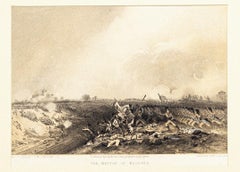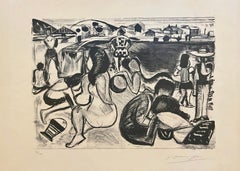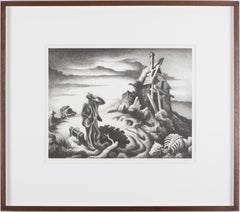Carlo Bossoli Figurative Prints
to
1
Overall Width
to
Overall Height
to
2
860
382
379
308
1
1
1
1
1
Artist: Carlo Bossoli
The Battle of Magenta -Hand Colored Lithograph by Carlo Bossoli - 1854
By Carlo Bossoli
Located in Roma, IT
The Battle of Magenta is original Hand-colored lithography on paper, realized by Carlo Bossoli in the XIX century. Titled on the lower center, signed on ...
Category
1850s Carlo Bossoli Figurative Prints
Materials
Lithograph
Related Items
Untitled abstract seaside, original lithograph
By François Desnoyer
Located in Belgrade, MT
Pencil signed black and white lithograph original limited edition pencil signed , Guilde De La Gravure. Mid 20th Century, part of my private collection. Very Good condition.
Category
Mid-20th Century Cubist Carlo Bossoli Figurative Prints
Materials
Lithograph
$636 Sale Price
33% Off
H 13 in W 15 in
Prodigal Son
By Thomas Hart Benton
Located in London, GB
A man raises his hand to his chin, his neck tilted and face turned to look at a dilapidated farmhouse, barely held together by planks of wood and exposed to the elements. Behind him ...
Category
1930s American Modern Carlo Bossoli Figurative Prints
Materials
Lithograph
Clemente Untitled B: surreal mythical landscape, voyage with ocean, Venus, snake
By Francesco Clemente
Located in New York, NY
A black and white, large-scale surreal mythical landscape of an ocean voyage, with a snake wrapped around a clock, a ship, Venus sculpture, greek urns, and snakes, printed in black o...
Category
1980s Contemporary Carlo Bossoli Figurative Prints
Materials
Lithograph
$2,975
H 26.75 in W 119.25 in
“Thebes, Great Hall at Karnak”
By David Roberts
Located in San Francisco, CA
This lithograph titled "Thebes, Great Hall at Karnak" is a notable work by the Scottish painter David Roberts (1796-1864). This particular scene is part of Roberts' most famous colle...
Category
1840s English School Carlo Bossoli Figurative Prints
Materials
Paper, Lithograph
Down the River
By Thomas Hart Benton
Located in London, GB
In this sentimental work from 1939, Benton expresses his admiration for the rural lifestyle of the Midwest. He highlights the connection between man and the land by depicting two fig...
Category
1930s American Modern Carlo Bossoli Figurative Prints
Materials
Lithograph
“Winter” from the “Four Seasons Suite” Series
By Alvar Sunol Munoz-Ramos
Located in San Francisco, CA
This embossed, numbered and signed lithograph, part of the “Four Seasons Suite,” is by Alvar Suñol Muñoz-Ramos (b. 1935), a renowned Spanish ar...
Category
1970s Modern Carlo Bossoli Figurative Prints
Materials
Paper, Lithograph
$1,350
H 37.25 in W 30.5 in D 2 in
Vintage David Hockney Poster Miami New World Festival of Arts 1982 palm trees
By David Hockney
Located in New York, NY
This vintage David Hockney poster features whimsical imagery and rich, bright color. Palm trees, boats in the ocean, a cafe, and a bodega with an elaborate iron-wrought balcony sit a...
Category
1980s Realist Carlo Bossoli Figurative Prints
Materials
Lithograph
Nature Morte Harvest scene
By Maurice Savin
Located in Belgrade, MT
This lithograph is part of my private collection. It is original and pencil signed an numbered by the artist.
It is one of a kind in black and white.
Category
Mid-20th Century Abstract Expressionist Carlo Bossoli Figurative Prints
Materials
Engraving, Lithograph
"Gothic Gables" New York Graphic Society 1966, Printed in Switzerland
By Lyonel Feininger
Located in Chesterfield, MI
"Gothic Gables" Poster/Print by LYONEL FEININGER (American-German, 1871-1956). The print measures approximately 20 x 27 inches and is unframed. Published by New York Graphic Society 1966. Printed in Switzerland...
Category
1960s Carlo Bossoli Figurative Prints
Materials
Lithograph
$160 Sale Price
20% Off
H 20 in W 27 in
Hong Kong urbanscape lithograph
By Ramon Moscardo Fernandez
Located in Sitges, Barcelona
Josep Moscardó (1953) - Girona Cathedral
Lithograph - Hand signed
Lithograph measures 54x76 cm.
Frameless.
Numbered 12/150
Barcelona, 1953
Painter, sculptor and draftsman of deep-r...
Category
1990s Fauvist Carlo Bossoli Figurative Prints
Materials
Lithograph
$401 Sale Price
43% Off
H 21.26 in W 29.93 in
Joseph Hirsch "September Morn" Rare Variant Signed / Numbered, circa 1960s
By Joseph Hirsch
Located in San Francisco, CA
Joseph Hirsch (1910-1981) "September Morn" rare variant signed / numbered, circa 1960s
"September Morn" is most recognized in its color variant. This i...
Category
Mid-20th Century Other Art Style Carlo Bossoli Figurative Prints
Materials
Lithograph
$975
H 18.75 in W 25 in D 2 in
The Departure of the Argonaut Francesco Clemente (bound book) Alberto Savinio
By Francesco Clemente
Located in New York, NY
The Departure of the Argonaut (1918) is the travelogue and wartime diary of Alberto Savinio, one of the seminal figures in twentieth-century Italian arts and letters. Clemente's acco...
Category
1980s Abstract Carlo Bossoli Figurative Prints
Materials
Lithograph
$7,500
H 26 in W 20 in D 2 in
Carlo Bossoli figurative prints for sale on 1stDibs.
Find a wide variety of authentic Carlo Bossoli figurative prints available for sale on 1stDibs. You can also browse by medium to find art by Carlo Bossoli in lithograph and more. Not every interior allows for large Carlo Bossoli figurative prints, so small editions measuring 10 inches across are available. Customers who are interested in this artist might also find the work of Antonio Fontanesi, Carlo Perrin, and Mario Logli. Carlo Bossoli figurative prints prices can differ depending upon medium, time period and other attributes. On 1stDibs, the price for these items starts at $332 and tops out at $332, while the average work can sell for $332.


